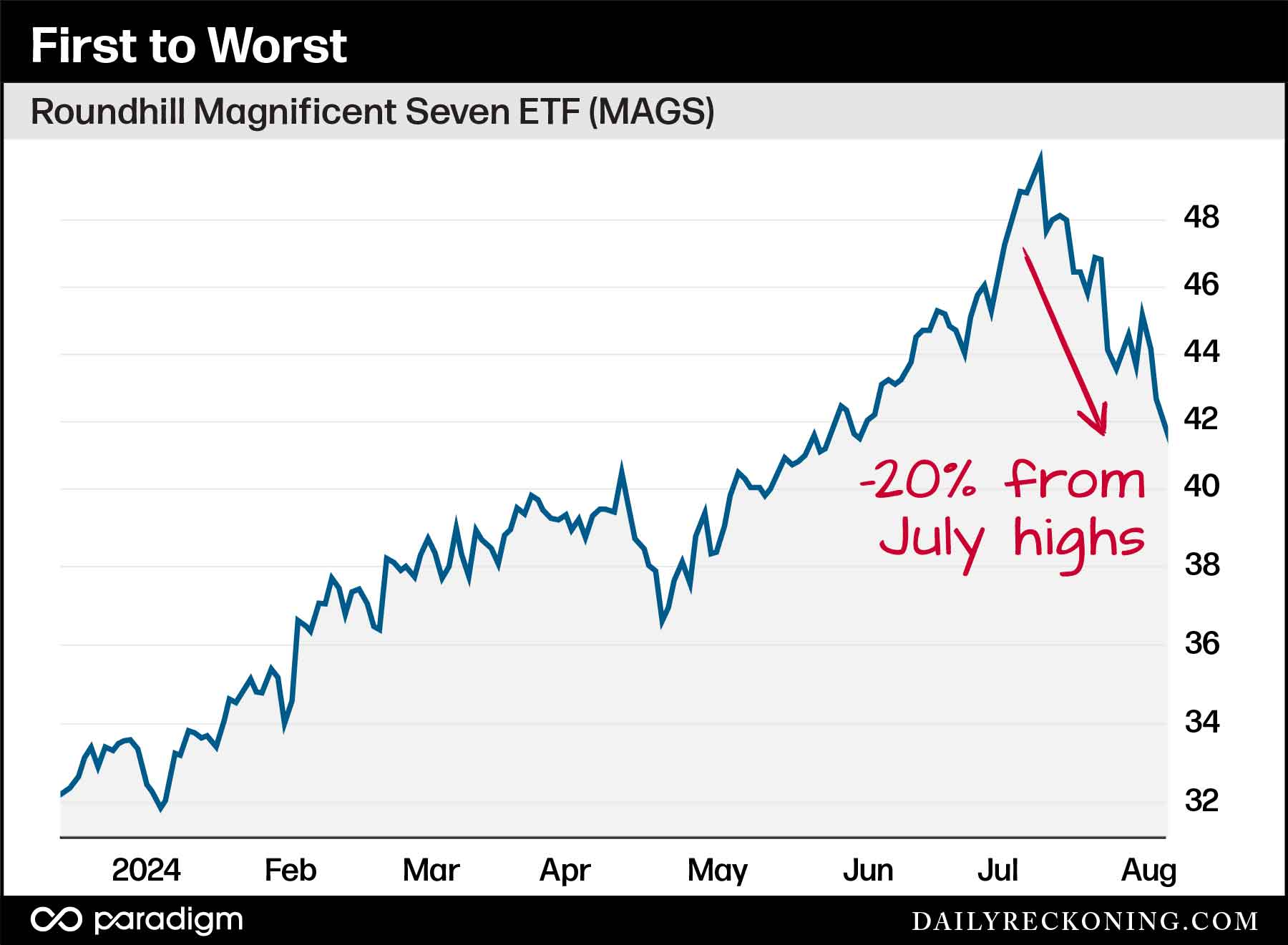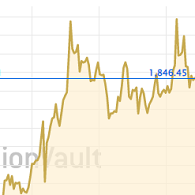Buy the Crash in Stocks?
When it's really time to buy, you won't want to...
I WAS enjoying a cocktail on my neighbor's porch last Saturday night when
the skies suddenly changed,
writes Greg Guenther in Addison Wiggin's Daily
Reckoning.
Thunder rolled in as the horizon turned an ominous
shade of
purple and the wind began bending the treetops. We retreated inside just a few moments later as the
first raindrops fell and watched
the storm unfold from the safety of the kitchen.
It was gone almost as quickly
as it appeared – but the
powerful storm left plenty of damage in its wake. Residents reported power outages, more than 400 downed
trees, and 170 blocked
roadways throughout the city.
Aside from a few short power outages, my
neighborhood was spared. The only
evidence in the yard were a few stray sticks and branches, which we cleaned up on Sunday afternoon
before I sat down at my desk to
survey the markets and prepare for the new trading week...
As you might
imagine, I couldn't help but think
the universe was toying with me when I saw the market begin to unravel in Japan and spread through
crypto and the futures
market.
Stocks were in freefall – no doubt about that.
But how long would the storm
last?
Before we attempt to answer this question, let's take a minute to review
how it all went
down...
Japan found itself in meltdown mode as the Yen carry trade [borrowing
the Japanese currency at 0%
interest rates and buying other, higher-rate currencies or assets] imploded and global recession fears
spread. The Nikkei fell more
than 12% on Monday, which the WSJ notes is its biggest drop since the 1987 crash.
Of course, the selling
didn't stop there. The bloodshed in the Asian markets spread into crypto, which spilled over to US
equities by the early morning
hours. We were already seeing some small pockets of worry crop up late last week, which began to
snowball early Monday morning. You
always know the market is making waves when non-financial types are posting about the carnage on social
media – and the panic was
certainly palpable Monday morning.
The market was dumping and the VIX spiked to
levels not seen since the
Covid crash. The bell rang – and investors started selling.
These are the days
that put traders and investors
to the test. How you react to major selloffs can affect your portfolio for months to come. If you aren't
prepared and you begin to
make panicked decisions, you can cause serious damage to your returns.
In
"meltdown" situations, the
survivors will be those who can remain calm and focused when everyone else is running around with their
hair on fire.
While I can't yet tell you how the averages will look at the end of the week, we can
discuss what to expect in a higher
volatility environment like the one we're entering right now – and how you should adjust your trading
strategy as stocks sail into
rough waters.
#1. When Investors are Scared, Cash is
King
Even in bullish
conditions, the market rarely cares about any of the amazing stories about your favorite investments.
You can't argue fundamentals or
growth stories in a crashing market. If panic conditions emerge, investors only want cash. They crave
safety above everything
else.
Crypto is the perfect example of this phenomenon. I know there are plenty
of folks who argue that
Bitcoin is a safe haven investment. But the market says otherwise! Crypto actually trades like a risk
asset.
That's why we watched Bitcoin get smashed into the low $50K range late Sunday as more than a few crypto
traders were liquidated. When
the margin call comes, the only way to pay is cold, hard cash!
If investors are
raising cash, they will sell
anything and everything, even gold. You might remember that gold even dropped a staggering 25% during
the throes of the August to
October 2008 meltdown. Keep in mind, this was in the middle of a huge bull cycle for gold, which was
unceremoniously interrupted by
the Lehman Brothers bankruptcy and the ensuing financial crisis.
Investors will
also sell their big winners
during these times of distress. The VanEck Semiconductor ETF (SMH) has tumbled nearly 30% from its July
highs. The Nasdaq 100 is down
15% over the same timeframe.

Yes, even the
bulletproof Magnificent Seven
stocks are collectively more than 20% off their all-time highs.
#2.
Stocks "Hold Hands" During Down
Markets
The market becomes highly correlated during drawdowns and panic
events.
What
does this mean?
Simply put, on the big, sweeping down days and crashes, most
groups and asset classes react
with similar moves.
Correlations are lower during bull markets. You'll have big
winners, middling names, and
laggards. Think about how the market was acting earlier this year. We have semiconductor stocks leading
the market by a mile, many
tech names also cruising higher (just not as much), while other sectors lagged.
That doesn't happen during
sustained drawdowns. When everyone is fighting for the exits, very few areas are safe from the sellers.
And I'd venture to guess that
most of the visible stocks will be down about the same as the averages during these dumps, with some of
the higher-flying names from
the past few months taking some bigger hits.
When sentiment sours and investors
become more cautious and
defensive, it's that much more difficult for individual groups to outperform.
#3. Respect the
Swings
When markets suddenly get squirrely, you probably experience a strong urge
to do something, anything, to
right the ship.
But part of investing or trading is simply surviving. After
all, you have to preserve your
capital if you want to stay in the game! And since we just experienced a severe volatility spike, it's
important to remember that
we're probably going to see strong moves both higher and lower in this new environment.
Volatility can be
your best friend or your worst enemy. If you're a longer-term investor, you have a great opportunity to
start nibbling at some of your
favorite companies (If you liked it at $70, you'll love it at $50, right?)
If
you're a trader, you'll want to
look to compress your timeframes. Yes, you can take advantage of the bigger swings. But you'll want to
take profits when you can,
because the market's more likely to experience back-and-forth action. Take what you can get, then move
on!
As
for finding the absolute bottom following a market downturn, don't forget what legendary technician
Walter Deemer says: "When the time
comes to buy, you won't want to."













 Email
us
Email
us
